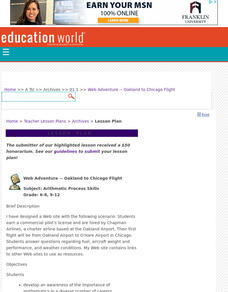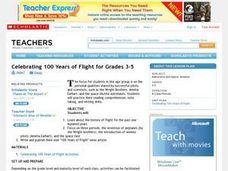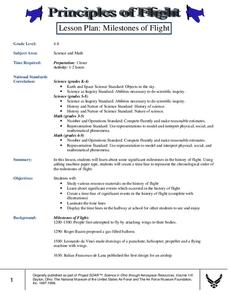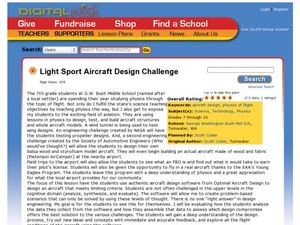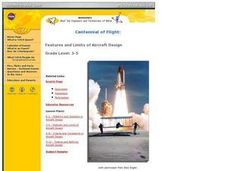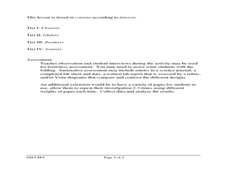K20 LEARN
Airplanes and Airstrips, Part 2
Table the decision to land. Pupils form flight crews by matching up different representations of linear equations. Given a set of coordinates for an airstrip, the crews determine the equation of the line that will position their planes...
Teach Engineering
Will It Fly?
Go fly a kite, then fly a plane! The 19th part of a 22-part unit on aviation looks at the way kites and gliders help aid in the understanding of flight. Pupils discuss how engineers used kites to influence airplane designs.
Teach Engineering
Balsa Glider Competition
Change one variable and try again. Teams build basic balsa gliders and collect data on their flight distances and times. Through collaboration, the team decides on two modifications to make to the basic design and collect data for the...
Teach Engineering
Better By Design
Which modification is the best? Using the scientific method, pairs determine the effects of each control surface on the distance of a glider's flight. The activity, section 16 in a 22-part unit on aviation, allows pupils to gain a better...
Teach Engineering
Airplane Tails and Wings: Are You in Control?
Keep everything under control. The lesson, the 16th segment in a 22-part unit, provides a more detailed look at the parts of a plane, specifically the control surfaces. Pupils learn about the construction of the wings and the tails and...
Teach Engineering
May the Force Be With You: Thrust
Force the plane through the air. The lesson introduces the force on an airplane that makes it go forward. Pupils learn how Newton's laws of motion apply to flight in the eighth segment of a 22-part unit on flight.
Curated OER
Web Adventure -- Oakland to Chicago Flight
Students develop an awareness of mathematics in a diverse number of careers, then describe three duties of a pilot that require mathematical skills. They increase understanding of interpreting data relationships presented in table format.
Curated OER
How Airplanes Fly?
Fifth graders explore drag, thrust, lift and weight. In this airplane lesson, 5th graders define the forces that effect airplanes and design a model airplane. Students compare their models for the furthest flight.
Curated OER
Measurement and Paper Airplanes
Sixth graders investigate physics by creating paper airplanes. In this flight experiment lesson, 6th graders utilize stationary tools to create elaborate paper airplanes which they fly on their school grounds. Students complete...
Curated OER
Early Attempts at Flight
Students investigate the early history of flight. In this aviation history instructional activity, students are split into six groups to research the development of the ornithopter, hot air balloon and the glider. Each group records...
Curated OER
Forces of Flight - Lift
Students design and test paper airplanes to understand the concept of lift and how it affects flight. This technology-based Science lesson is excellent for use with upper-elementary and middle-level learners and uses spreadsheet software...
Curated OER
History of Flight Timeline Activity
Scholars are introduced to the significant events that led to the development of today's modern forms of air travel. They create a timeline to identify the vital events that are related to man's flight. In addition, they research various...
Curated OER
Sculptures from the Skies
Fourth graders research the design of the aircraft used by the Wright Brothers at Kitty Hawk. They design a sculpture of aircraft using recycled materials.
Curated OER
New Perspectives
Eighth graders imagine they are getting ready to "take off." They may imagine themselves in any type of aircraft or spaceship. They may then sketch themselves as passengers anticipating this moment.
Curated OER
How Do Airplanes Fly?
Students study the concepts of air pressure, air speed, and gravity as it relates to airplanes. In this how do airplanes fly lesson plan, students study the basics of flight. Then reinforce their fine motor skills by creating airplane...
Curated OER
Celebrating 100 Years of Flight for Grades 3-5
Students study the history of flight of the past one hundred years, focusing on the invention of the airplane, the introduction of women pilots and the space race. They conduct research and then write and publish a "100 Years of Flight"...
Curated OER
Lift and Drag: Principles of Flight and the Soaring Imagination
Students construct models of early gas balloons and gliders. In this balloon and glider lesson, students create models of early gas balloons and gliders, discover how the forces of lift and drag effect aircraft in flight, and put on...
Curated OER
Testing and Refining Aircraft Design
Learners design and make a flying device. They work in small groups to brainstorm ideas for the design of their device. They choose an idea or combination of ideas to use for their design and create a sketch of their design. The students...
Curated OER
Problems and Solutions in Aircraft Design
Students watch demonstrations of paper folded designs that do and do not fly and discuss their observations. They identify problems that they, the Wright Brothers, or NASA scientists face when designing an aircraft, and identify...
Curated OER
Milestones of Flight
Learners identify significant milestones in the history of flight. In this aviation history lesson plan, students study various resource materials and construct timelines of significant achievements.
Curated OER
Light Sport Aircraft Design Challenge
Students investigate aircraft design to learn many concepts of physics. In this aircraft design lesson, students use balsa wood and styrofoam to build an aircraft based on their study of wing designs, aviation, and through the use of an...
Curated OER
Features and Limits of Aircraft Design
Students identify the desired features of an aircraft and the limits that they, the Wright Brothers, or NASA scientists might face in designing one, and methods to solve these. They review parts of an airplane and what makes it fly. They...
Curated OER
Origami Flight: The Physical Setting
Sixth graders investigate the forces that move certain objects. In this physics lesson, 6th graders design and create paper flying objects using origami methods, which they practice flying in different conditions. Students record and...
NASA
Resolving 3-Plane Traffic Conflicts by Changing Speed—Problem Set F
Get three planes to line up safely. Individuals work through a set of problems to eliminate spacing conflicts between three airplanes in flight. The pupils use their knowledge to change the airplanes' speed or route to meet a...
Other popular searches
- Flight, Aviation Powerpoint
- Flight Aviation Powerpoint
- Flight, Aviation Activities
- Aviation Flight
- Flight Aviation Activities
- Aviation Flight Trainging








